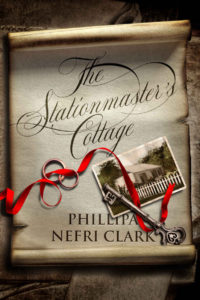 Title: The Stationmaster’s Cottage
Title: The Stationmaster’s Cottage
Author: Phillipa Nefri Clark
Designer: Steam Power Studios
Genre: Romance
Graphics: It is not often one comes across a book cover that actually looks three-dimensional. Oh, there are plenty of fantasy or thriller covers that have three-dimensional aspects, but this cover has the three-dimensionality of a photograph. That’s a rare thing.
The image lies in three layers too. The furthest back appears to be a table or a something that looks more rocky than wooden. The middle layer is the parchment, rolled at the top and bottom and burned on the edges. The parchment’s shadow suggests that it floats an inch off the surface.
Then there are the modern additions: photograph, key, rings, ribbon. The ribbon ties the rings together and itself is sandwiched between the photo and the key. Somehow, it is implied, these things are connected with one another. The building in the photo must be the cottage in the title. The key? It doesn’t look like a house key, so it might belong to another building—perhaps the station itself.
In terms of symbolism and place, this cover excels. The keys make it clear it’s a romance. The old-timey look to the parchment, key, and cottage suggest that, even if the action takes place chiefly in the present, an earlier era is part of the story. The graphics alone make this a book that even a non-reader of romance novels likely would open.
Typography: The cover has only two textual elements, the title and the author name. The first thing that might pop into a viewer’s mind is that the title couldn’t have been set in a standard font. Given its flowing swirls, it had to be hand drawn—or was it? Look at the letters carefully. Each E is exactly the same. Likewise each T, O, and A. Real handwriting can’t produce such uniformity.
However the title was made, one has to say it looks almost perfect—not quite, but almost. The grand swirl at the top crosses the final S in “Stationmaster’s,” somewhat obscuring that letter. Despite that, the word is legible. The whole title is legible, even at thumbnail size.
The same can’t be said of the author name. Parts of several letters are hidden behind the photo and ribbon, for no obvious purpose.
The ribbon ought to have been moved up and to the right a smidgen to give air to the A and the K, and the photo should have been rotated slightly to reveal the L and I. When the image is at full size, all those letters are clear, but when it’s at a small size they aren’t.
Overall: This is close to being an errorless cover.
If the rings weren’t present, the genre wouldn’t be clear, and a tagline would have been necessary. I suppose someone might wish for a more explicit indication of the genre, but I wouldn’t call the cover’s subtle way to be a problem.
Really, the only weakness—and it is a small one—is the obscuring of a few letters.
